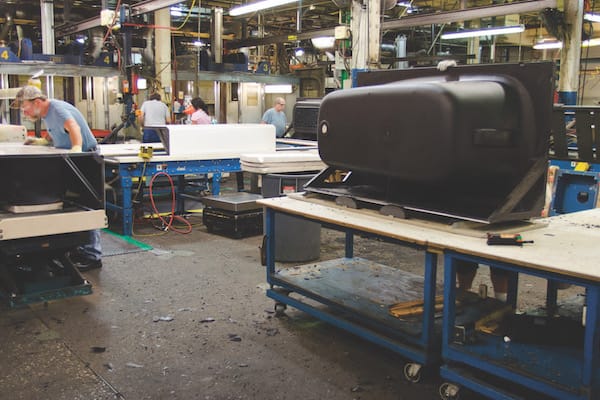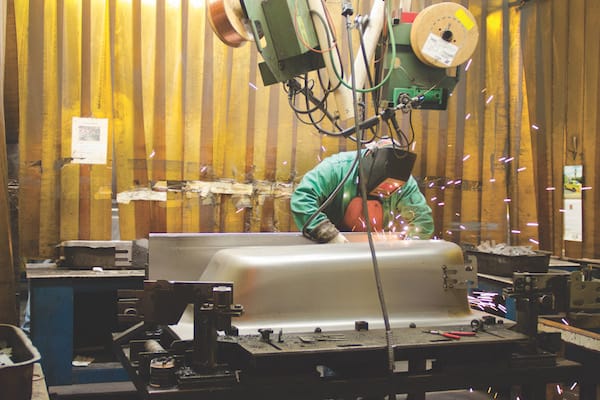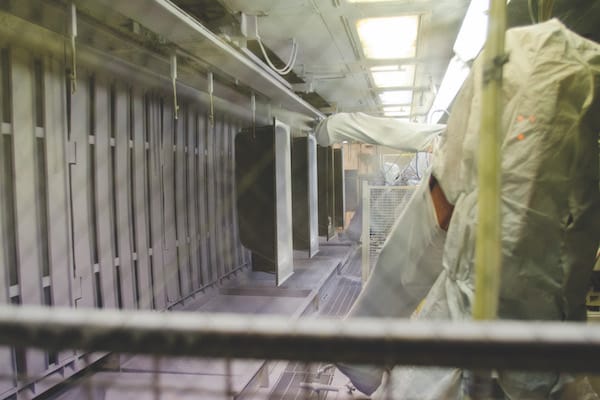Once a manufacturing mecca in the 1920s and 30s, the small eastern Ohio town located in the Rust Belt region of America is host to American Standard’s Americast plant. As members of the trade press assembled at the American Standard facility in Salem, Gray Uhl, Brand Education Director, Lixil Water Technology—one of the trusted tour guides for the day—explained that the plant has continued to produce Americast bathtubs for nearly 30 years—one Americast tub per minute, as a matter of fact—in addition to porcelain enamel on steel bathtubs, and acrylic tubs and whirlpools.
A long-time employer in eastern Ohio, the invention of Americast in the 1980s helped to revitalize this plant and local economy that had been depending on steel for so many years. “The materials and the intellectual skill to work with them was already there in the area,” says Uhl.
 Americast is an exclusive, patented material used in American Standard bathtubs, which features American Standard’s unique patented process that fully bonds a high quality porcelain surface with an enameling grade steel and a molded reinforcement composite backing. It is durable and weighs less than cast iron so it costs less to install. “American Standard reached out to the automotive and aerospace industries; the Americast composite material is similar to those used in those particular industries,” says Uhl.
Americast is an exclusive, patented material used in American Standard bathtubs, which features American Standard’s unique patented process that fully bonds a high quality porcelain surface with an enameling grade steel and a molded reinforcement composite backing. It is durable and weighs less than cast iron so it costs less to install. “American Standard reached out to the automotive and aerospace industries; the Americast composite material is similar to those used in those particular industries,” says Uhl.
Although it weighs half as much as traditional cast iron, making it less costly to install, Americast’s patented three-layer construction offers superior durability, heat retention and sound dampening qualities. These characteristics have made Americast the bathtub of choice for commercial specifiers, installers and end users for decades. Americast has its benefits over cast iron, say Uhl, “Cast iron is difficult to install/ship and the warping and twisting that occurs in the firing process leads to dimensional instability. In addition, cast iron sucks the heat out of the hot water in the tub.”

When coated, the tub is put into a mold and pressurized. The Americast resin technology (third of three-layer process) is applied to back of porcelain enamel coated steel bathtub.
The patented Americast three-layer construction, combining a porcelain enamel finish with enameling grade metal and a structural composite, was invented and introduced to the building and construction market. Americast was used in the first Princeton bathtubs, offering builders and homeowners a durable, lightweight alternative to cast iron with superior heat retention and noise reduction.
Pioneered following several years of research and development, the unique three-layer construction of Americast consists of a smooth porcelain-enamel finish on high-quality alloy, backed by an injection-molded structural composite. The composite material helps protect the porcelain finish from surface chipping and crazing—lines/cracks in surface—caused by reverse impact damage. The patented Americast composition gives bathtubs a tight radius at corners for maximum useable space in residential and hospitality bathroom settings.
 The Americast process was also used to craft the company’s popular collection of Silhouette kitchen sinks, which showcased a range of fashion colors while offering flexible installations options. The unique composition of Americast gives products a tight radius at corners for maximum usable space in tubs and sinks.
The Americast process was also used to craft the company’s popular collection of Silhouette kitchen sinks, which showcased a range of fashion colors while offering flexible installations options. The unique composition of Americast gives products a tight radius at corners for maximum usable space in tubs and sinks.
A pre-fabricated leveling grid underneath the tub provides extra support to the tub floor to prevent warping and cracking. This grid allows the tub to be easily slid into place or bedded in mortar, while also saving time when leveling. “We recently improved the skid pattern and the reformatted design increases coverage by 40%,” says Uhl.
Offering added flexibility for builders, an optional above-the-floor rough installation leaves a few inches of clearance between the tub’s underside and the flooring so that pipe can be routed without breaking ground or relocating the drain.




Join the conversation: